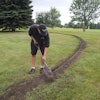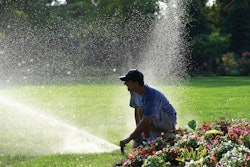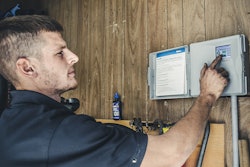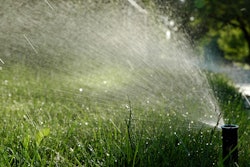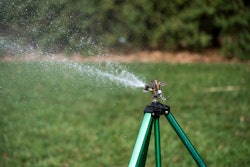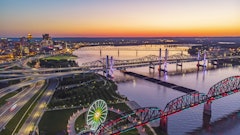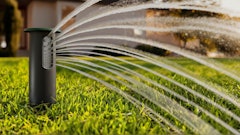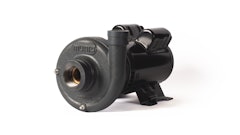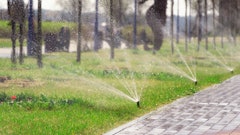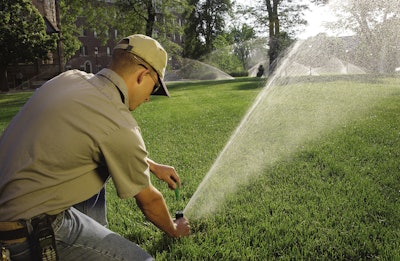
No matter your location, if water is not an issue, it should be. We all know how vital water is for life. We know the importance of plants. We know that plants not only need water for their survival; most need supplemental watering from time to time. Thus, we have a very active irrigation industry.
That industry has been evolving, with many changes over the last few years. Manufacturers are constantly looking for new ways to most efficiently get water to plants in the most economical way. One of the big areas taken into consideration is cutting down on the amount of water wasted—preventing overwatering or runoff as much as possible.
In talking with manufacturers and irrigation contractors, the primary trends seem to be:
- Smart irrigation control
- More efficient emission devices
- More use of drip irrigation
- Considering alternate water supplies
- Better customer education
1. Smart irrigation control
Shannon Geno, sales manager for Rain Bird’s Water Conservation Team, says, “New technology is allowing irrigation to become smarter by taking both environmental factors and plant needs into consideration. We know what watering requirements a particular plant has, and now we’re able to install controllers with sensors and smarter programming to better understand the plant’s location, the topography and climate.”
Technology factors in the amount of water coming out of the soil using evapotranspiration (ET) and moisture sensors to know when and how much water to apply. Factors such as soil type and slope can also be used to determine how much water can be applied before the soil reaches capacity and creates runoff.
While we have had smart controllers for a while that take actual weather conditions into consideration, new, smarter ones will look forward at forecasted weather. They can hold off on water if rain is in the forecast or program extra water if a heat wave is coming.
Todd Polderman, marketing strategy manager at Hunter Industries, reports, “There are now several residential-grade controllers available on the market today that use a smartphone or tablet as the interface to access the controller. These offer a means to access the controller from the internet to more easily program the controller initially, and make program adjustments to the controller more frequently.”
Companies that make home-automation systems are starting to add irrigation to the items that can be controlled with their systems along with lights, alarms, security, climate control and entertainment. Those companies include Creston, Lutron and Savant.
2. More efficient emission devices
Manufacturers are combating inefficiency with advanced features and designs on their emission devices. Geno says, “We know high water pressure contributes greatly to water waste, using millions of extra gallons a year.”
Rain Bird is using what it calls “PRS” or “Pressure Regulating Stems” in its rotors and sprays to control water pressure at each head. The company also has improved nozzle technology with devices that use thicker streams of water and lower trajectories to fight wind drift and improve the amount of water landing in the intended target area.
Complete system regulators and valve-pressure regulators are also improving as more and more communities are making pressure regulation a requirement. Hunter reports up to 30% more efficiency with some of its nozzle technology. Polderman says, “Some of these also supply water more slowly, allowing tighter soils to absorb more of the water before runoff occurs.”
3. More use of drip irrigation
Drip irrigation puts that water right where it is needed; no more water on walls, windows, sidewalks and streets. Drip also promotes healthier plants because water is delivered more slowly and at lower pressures at or near the root zone. Water loss due to ET is virtually eliminated. While drip irrigation was previously intended for flowers, vegetables, trees and shrubs, new products are now making it possible to be used on turf.
Rain Bird has a product it calls XFS Subsurface Dripline that provides a vehicle to irrigate areas of turfgrass with highly efficient technology. Hunter also has a Subsurface Drip Irrigation (SSDI) system that it calls “Eco-Mat.” Two additional advantages of such systems include cutting down on vandalism and using subsurface technology as a means of applying minimally treated gray water and fertilizers—eliminating the concerns of human contact with these substances.
4. Alternate water supplies
While well-established in the Southwest and Southeast, use of reclaimed water is expanding to other markets. This seems to be especially the case in those areas with older infrastructure. Polderman says, “Just like recycling, it is the right thing to do as stewards of the environment.”
Use of home-generated gray water is another alternate water supply. Polderman reports, “Reusing water from showers and washing machines with minimal treatment is also gaining acceptance. Recent legislative changes in California and other states make this more accepted. Research by the green roof industry also has shown gray water to be a smart and safe practice for water-starved areas.”
5. Better customer education
Irrigation manufacturers are providing more tools for irrigation contractors to use in educating their customers and potential customers on the need for, and features and benefits of, the more efficient use of water. They are using their websites and social media to get the word out. Online videos, marketing pieces, webinars and promotions are all part of the tools that help deliver the information.
Geno says, “We help contractors and their customers understand the ROI of smarter irrigation by sharing the real-world data that we’ve gathered through research and special initiatives. We offer several water-saving calculators online (Rainbird.com). The calculators ask some very general questions about a client’s site, then quickly calculate ROI on the investment, and are fundamental in driving customers into more efficient products.”
Irrigation contractors should take advantage of these and other programs to grow their business in a way that helps their customers, their bottom line and the environment. Bob Grover, president of Pacific Landscape Management in the Portland, OR, area says, “We took several of our staff members to the Irrigation Association annual tradeshow last November. We evaluated many of the newest water-management products and will begin to propose the appropriate product for each property we maintain starting this spring.”
While water shortages are not good, they will continue to be a fact of life. Continue to monitor all the latest innovations and information to offer the best water management practices to your customers.


